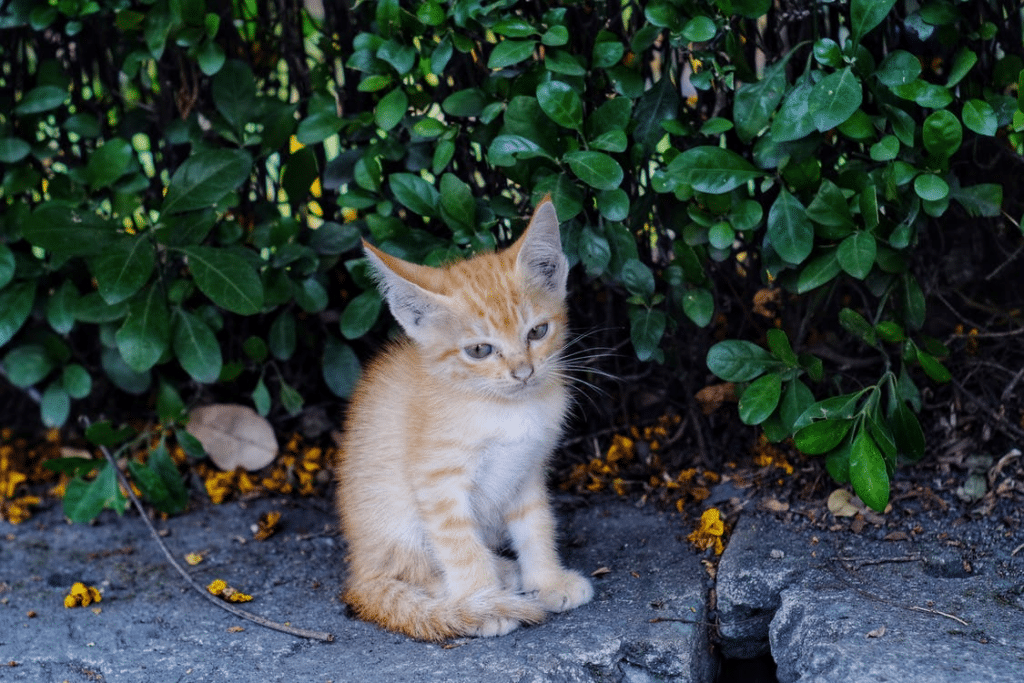Community cats, often known as feral cats, are feral cats that live in the wild. They, like indoor cats, are members of the domestic cat family. We usually send cat cases to county animal control or, better yet, local TNR (Trap, Neuter, Release) organizations. On the other hand, community cats are rarely socialized or pleasant to people, making them unadoptable.
People in cities and suburbs may never be completely free of these felines, but there are several things you can take to keep them off your property. They enjoy entire, robust lives in their outdoor houses with their feline families, known as colonies. Feral cats can cause a problems you better know How To Get Rid Of Feral Cats Permanently.
Cats may look cute and harmless, but they can pose problems if they decide to make your yard their eating spot or playground. They could transform your yard into their own litter box, bringing parasites and fleas along for the ride.
You’ll need to figure out how to keep feral cats out of your flower beds if they’re ruining them.
Cats are adorable and entertaining to have around…until they aren’t, as when feral cats chase away your yard’s birds and use your lawn as a litter box. Furthermore, Feral cats can infect your domestic pets, which you certainly don’t want. Many people want to get rid of feral cats in their yards, but few of us want to do it cruelly.
Fortunately, there are various methods for getting rid of feral cats and preventingFeral cats from utilizing your yard as their own litter box and giving you difficulties. Fortunately, you can take a few simple steps to help. Here are some ideas for preventingFeral cats from entering your yard.
You Need to Keep Feral Cats Away, Because…
Naturally, we adore cats from all walks of life. That isn’t to say that unwelcome visitors are always welcome. Cats may be destructive, and feral cats can also bring disease.
Before you take in a new cat, it is essential to determine what type of kitty it is and whether it is safe to welcome it into your home. You can identify a feral cat from a stray one by checking for an ear tip, which is usually a sign that the cat has been neutered as part of the trap-neuter-return process performed on wild cats.
Once you identify it, it’s time to get rid of it.
There are dozens of reasons why you need to keep cats away from or get rid of them. Let’s get to know some;
- Free-roaming cat populations have been identified as a significant public health threat. They are sources of several zoonotic diseases, including rabies, toxoplasmosis, and cutaneous larval migrants because of various nematode parasites, plague, tularemia, and murine typhus. Toxoplasmosis, cat roundworm, and cat-scratch disease are caused by pathogens that depend on cats — pets or feral — for part of their life cycle. But these diseases can be passed to humans, sometimes with severe health consequences.
- A stray, feral or terrified cat can turn on a dime. Expert veterinarians, animal health technicians, and animal inspectors still suffer a terrible cat bite or scratch on occasion, even when all precautions have been taken. Feral cats generally avoid human interactions unless they are forced into a situation they cannot escape from. Caution is the word of the day when approaching an unknown cat.
- Stray cats are active during the day, while feral cats are primarily nocturnal. Stray cats could look dirty and messy, but feral cats could have a clean, well-kept coats. This is a universal sign that the animal has been spayed or neutered through a feral surgical clinic.
- According to experts, cats are “surplus killers,” meaning they kill more prey than they eat. Their inherent hunting instincts are still present, but they prefer the thrill of the pursuit over the capture. They may regard killing their victim as the conclusion of a game they desire to continue. They receive the most satisfaction from their capture by releasing, re-catching, and tossing it around. Surplus killing is also practiced by honey badgers, bears, dogs, orcas, and other creatures. On the other hand, feral cats are the most prevalent excess killers in urban areas. At the same time, rats are a common urban scavenger.

How To Get Rid Of Feral Cats Permanently
Now let’s get down with our main event and learn how you can Get Rid Of Feral Cats PERMANENTLY. Use the simple steps below.
Step 1: Removing Food and Shelter Sources
Cats are drawn to regions that give food and warm, dry refuge from the elements. You may make your house less tempting by removing any possible food sources on your property. Human leftovers are one of the most common food sources for wild cats. Therefore they remove waste and protect disposal bins.
Remember that cats can survive on very little food, so totally eliminating their food sources in your region may be impossible. Make sure you’re not leaving any organic food leftovers out in the open. Also, encourage your neighbors to close their garbage cans with tight-fitting lids.
Keep them at least 30 feet (9.1 meters) away from your home if you must feed cats. Don’t put cats there if you don’t want cats to assemble at your front entrance. Close any minor gaps beneath your porch or deck with a fence, and ensure your shed door is securely shut. Remove woodpiles and shrubs to prevent cats from making their homes in these places.
Access to dry, covered areas such as porches, sheds, garages, and other structures should be restricted. Speak with your neighbors to make sure they’re taking measures as well; one welcome neighbor might result in a swarm of wild cats on your property.
Step 2: Use Water Sprinklers

Because cats, despite water, consider using a motion-activated sprinkler. This gadget detects movement and ejects a powerful blast of water with a diameter of up to 70 feet to chase away bothersome cats. As a result, you may want to invest in a water sprinkler that you can set to target cats who wander into your yard.
You may also buy an automatic water sprinkler to place up in specified sections of your yard to shower the cats’ bodies whenever they wander into your yard. It may also be used as a standard lawn sprayer because it has a continuous spray setting.
This motion-activated sprinkler functions wonderfully both at night and during the day. It’s also appropriate for any season. It includes ingenious sensor technology that turns on only when motion is detected, conserving both electricity and water.
When a cat enters the infrared field, the sprinkler discharges a blast of water for a few seconds in the animal’s general direction. Rather than soaking the cats, the effect is to scare them, and they will quickly learn to avoid the area.
Step 3: Use Coffee Ground with the water of your Water Sprinklers
Cats dislike the taste of coffee. The pungent odor of coffee might deter cats from entering your garden. Simply scatter your fresh, wet coffee grinds over your borders and plants to deter feline interest.
Coffee grinds may be helpful in the garden for a variety of reasons. Coffee granules may be utilized as a natural deterrent, causing cats to flee your yard. Coffee grounds, in fact, are disgusting to them. Coffee’s strong odor repels both cats and dogs. Wet coffee grinds can be dusted on their own or mixed in with your regular compost.
Gather enough old coffee grounds to cover the locations you wish to keep safe. Save the peels from old oranges or citrus fruits. Coffee grounds are repulsive to cats, and they will avoid areas where they are present. Others might be accustomed to the solid, concentrated aroma if they grew up in a house or yard that smelt like coffee all the time.
It not only keeps pesky wild weeds out of your greens, but it also increases the soil’s richness and purity. Coffee grinds completely disintegrate, refreshing your soil and promoting optimum growth.
Step 4: Use Ultrasonic Repeller

Ultrasonic repellers are both safe and efficient in repelling cats. Sound repellents are excellent, but they are effective against more than just cats. Noisemakers pollute the environment, so go for an ultrasonic cat repeller if you want to keep cats away with sound but don’t want to bother your family or neighbors.
It operates by producing an extremely high-pitched frequency – typically inaudible to humans – that cats loathe.
Ultrasonic repellers are similar to sound repellers in that they emit sounds that cats can hear but people cannot. The Pest Soldier, for example, is an excellent ultrasonic pest repellent.
They not only scare them away, but they also keep a variety of other pests out of your garden. Rats, rabbits, moles, dogs, and raccoons are examples.
The device must be placed against an outside wall for setup to be simple. To allow your dog to enjoy the garden while cats avoid it, adjust the pitch to target certain animals. Changing the modes can help you achieve more success. Change your strategies regularly since fresh cats in the area will be less susceptible to your methods.
Step 5: Use The Urine Of Predatory Animals To Deter Predators From Your Property
Applying the urine of coyotes or foxes to your home to discourage feral and stray cats away is another simple technique to get rid of cats. This may not be the ideal option because the urine must be reapplied regularly to be successful. Unfortunately, live near the seaside.
Unwanted cats may wreak havoc on your garden and yard. Wolf Urine for Cats is a great way to keep wild cats away. Wolves’ scent functions as a natural wild cat deterrent in yards.
When an animal approaches the treated area, he smells the urine. He assumes there is a predator around, so he flees in terror. With the terror element, powdered coyote and fox urine will keep domestic cats away.
The smell of ammonia is highly repulsive to dogs and cats. Purchase hazy ammonia and dilute it with ten parts water. Spray over the garden and yard, but test a small area first before using it on plants.
You could also come into this with urine-flavored creatures more significant than a cat.
Step 6: Make use of humane traps

Humane spring-loaded traps can effectively capture feral cats, which can be turned over to wildlife control officials or local shelters and rescues. Set traps in areas where cats congregate and bait them with appropriate food or enticing scents. However, be aware that you may capture a different animal, such as a raccoon or opossum.
Step 7: Contact Animal Control
Most towns have animal control officers who deal with wild animals or stray domestic animals that are a danger or a nuisance. The level of involvement varies according to the community. Some organisations will actually go out of their way to trap and remove an actual feral cat, while others will come to pick one up if you have trapped it yourself.
Step 8: Building Catproof Barrier {Best option}

In recent years, the cat-proof fence has become fashionable. Ironically, it’s frequently used to describe items that aren’t “cat-proof.” If you already have one, you may create a cat-proof fence out of wood, chain link, vinyl, block, metal, or brick.
The situation will be reversed in this scenario.
You may always build a barrier around your yard or garden if you have the area for it. A border fence of at least 1.8m (6ft) in height is required to keep cats out of a garden, which requires uprights of at least 2.3m (7ft 6in) in height in the event of a wooden construction so that there is enough length to install in the ground.
If your yard is already fenced, ensure no minor gaps that cats may slip through. To avoid this, reinforce any areas where a cat’s slinky body may squirm its way through. There are also caged fence solutions for your gardens, which allow your plants to be fully exposed to light while still remaining safe.
FAQ
What does a humane society do for feral cats?
Scatter fragrant items that don’t appeal to a cat’s sense of smell, such as fresh orange or lemon peels, organic citrus-scented sprays, coffee grounds, vinegar, pipe tobacco, or oil of lavender, lemongrass, Humane society groups assist by engaging in initiatives to get these cats spayed or neutered and vaccinated by catching them with a humane trap. As well as supporting the individuals who care for them in the community.
Is chicken wire effective in keeping cats out?
Cats are repulsed by the coarse, scratchy feel of chicken wire or bird netting. Both products are inexpensive and simple solutions to keep an unwanted cat out of garden beds and are readily available at most hardware shops. Put chicken wire or bird netting over your soil to create little pockets for your plants or flowers.
Does cayenne pepper keep stray cats away?
Capsaicin is the active ingredient in cayenne pepper that repels cats. Several commercial cat repellents include cayenne pepper and other natural oils such as eucalyptus oil. You may choose to make your own spray simply.
Is Alley Cat Allies a realistic organization?
Alley Cat Allies is a non-profit animal welfare organization founded on October 6, 1991. Based in Bethesda, Maryland, the organization is most recognized for bringing trap-neuter-return to the United States. It pushes for policy and institutional changes that will better serve the interests of cats.
Closing Words
Whether you have a single stray cat problem or are dealing with a large-scale invasion, the steps outlined above will assist you in regaining control of your home. If you are diligent, you may be able to completely prevent cats from accessing your yard or garden.
Natural cat repellents, ultrasonic devices, and physical deterrents like motion-activated sprinklers may be applied alone or in combination to eliminate stubborn, unpleasant cats in the yard.
